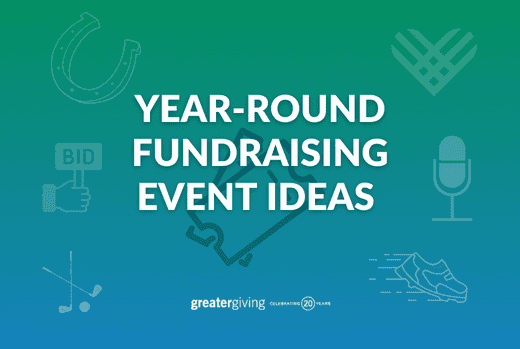Recognizing the Important Components of Nonprofit Fundraising: Trick Practices for Enhancing Monetary Sustainability
Not-for-profit fundraising is a diverse undertaking that needs a nuanced understanding of a number of crucial parts to ensure financial sustainability. From strategic preparation that lines up with mission-driven objectives to the farming of purposeful benefactor connections, each element plays a critical role in the general success of fundraising initiatives.
Strategic Fundraising Planning
Strategic fundraising preparation is a crucial part for any nonprofit company intending to achieve its mission successfully. This procedure involves establishing clear, measurable objectives that line up with the company's overall purposes while taking into consideration the unique requirements of the area it offers. A well-structured fundraising plan not just recognizes potential income resources but likewise lays out the tactics and methods necessary to engage those sources.

Additionally, leveraging information analytics can educate decision-making by providing insights into contributor habits and patterns, enabling nonprofits to tailor their fundraising methods accordingly. Normal testimonials and updates of the fundraising strategy are important to reply to altering conditions and emerging possibilities. Eventually, a thorough calculated fundraising strategy acts as a roadmap for nonprofits, cultivating economic security and allowing them to fulfill their mission properly.
Building Contributor Relationships
Structure solid donor partnerships is important for the lasting sustainability of any kind of nonprofit company. These relationships are the foundation upon which successful fundraising efforts are developed, as they foster count on, loyalty, and interaction among supporters. Nonprofits have to focus on cultivating meaningful connections with their contributors, identifying that each interaction can dramatically impact their desire to add.
To properly construct contributor partnerships, organizations must concentrate on individualized interaction methods. This entails recognizing the interests, motivations, and giving patterns of specific donors, allowing customized communication that resonates with them. Routine updates on business development, program results, and the effect of contributions reinforce the value of their support.
Moreover, expressing gratefulness is critical. Acknowledging contributions immediately and all the best not just boosts relationships but also motivates recurring support. Occasions such as benefactor admiration celebrations provide opportunities for personal connections and area building.
Ultimately, supporting benefactor relationships goes beyond transactional communications; it symbolizes a collaboration where benefactors really feel valued and indispensable to the goal. By spending time and sources in relationship-building, nonprofits can boost donor retention, increase lifetime providing, and make certain financial security for their campaigns.
Efficient Interaction Techniques
Reliable interaction techniques play a critical duty in enhancing the solid benefactor relationships that nonprofits strive find out here now to grow. Constant and clear messaging is important for conveying the objective, vision, and impact of the company. Expressing the special worth proposition aids contributors understand just how their contributions make a substantial difference.
Using numerous communication channels-- such as emails, social networks, newsletters, and in-person events-- makes certain that messages reach a diverse target market - Find Out More nonprofit agency. Tailoring communication to different contributor segments can enhance involvement; as an example, major benefactors might appreciate in-depth records on funding allowances, while smaller contributors may favor succinct updates highlighting vital achievements
Narration is one more effective tool in nonprofit interaction. Sharing engaging stories concerning recipients can stimulate psychological reactions and cultivate a much deeper link with the cause. Openness concerning financials and program outcomes builds count on, urging benefactors to stay engaged gradually.
Involving the Neighborhood
Neighborhood interaction is important for nonprofits seeking my response to enhance their impact and promote a sense of ownership amongst neighborhood stakeholders. Establishing a robust connection with the area not only enhances exposure yet likewise develops count on, critical for sustainable fundraising initiatives. By actively involving area participants in decision-making processes, nonprofits can straighten their objectives with the requirements and aspirations of the populace they serve.
To successfully engage the community, nonprofits should focus on transparency and open communication. Organizing public discussion forums, workshops, and informational sessions permits significant dialogue, where stakeholders can voice their point of views and contribute to the organization's vision. Moreover, working together with local organizations, colleges, and public organizations can create synergistic collaborations that leverage shared resources for better influence.
One more important facet of neighborhood engagement is recognizing and commemorating regional contributions. Recognizing advocates, volunteers, and benefactors fosters a sense of belonging and commitment, encouraging continued participation. Additionally, showcasing success tales and the concrete advantages of area support can motivate others to contribute.
Eventually, aggressive neighborhood interaction grows a network of supporters who are purchased the nonprofit's objective, guaranteeing lasting assistance and enhanced economic sustainability.
Making Use Of Innovation and Devices

One necessary tool for nonprofits is a detailed benefactor management system. These platforms allow companies to maintain thorough documents of benefactor choices, communications, and contributions, helping with individualized interaction and interaction (nonprofit agency). Additionally, utilizing on the internet fundraising systems allows nonprofits to get to a broader target market, making it easier for advocates to contribute with various networks, including social media sites and e-mail campaigns
In addition, using task administration devices can help simplify internal processes, making sure that fundraising groups continue to be organized and concentrated on their objectives. Automation software can likewise streamline repeated tasks, such as sending thank-you emails or suggestions, freeing up personnel time for even more calculated efforts.
Final Thought
In conclusion, the essential elements of not-for-profit fundraising encompass critical planning, solid benefactor connections, effective interaction, area involvement, and the usage of innovation. These components collectively add to enhancing financial sustainability and durability within nonprofit companies.
Furthermore, leveraging information analytics can notify decision-making by offering understandings into benefactor habits and patterns, enabling nonprofits to customize their fundraising approaches appropriately.Building solid benefactor connections is vital for the lasting sustainability of any type of not-for-profit organization.Efficient interaction techniques play a crucial function in enhancing the strong contributor partnerships that nonprofits make every effort to grow.One crucial device for nonprofits is a thorough donor monitoring system.In verdict, the vital components of not-for-profit fundraising include strategic preparation, strong benefactor relationships, reliable interaction, neighborhood interaction, and the application of modern technology.